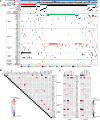This is a preprint.
Fusion oncoproteins and cooperating mutations define disease phenotypes in NUP98-rearranged leukemia
- PMID: 39974131
- PMCID: PMC11838931
- DOI: 10.1101/2025.01.21.25320683
Fusion oncoproteins and cooperating mutations define disease phenotypes in NUP98-rearranged leukemia
Update in
-
Fusion oncoproteins and cooperating mutations define disease phenotypes in NUP98-rearranged leukemia.Blood. 2025 Oct 23;146(17):2102-2118. doi: 10.1182/blood.2025028993. Blood. 2025. PMID: 40700635
Abstract
Leukemias with NUP98 rearrangements exhibit heterogeneous phenotypes correlated to fusion partners, whereas the mechanism responsible for this heterogeneity is poorly understood. Through genome-wide mutational and transcriptional analyses of 177 NUP98-rearranged leukemias, we show that cooperating alterations are associated with differentiation status even among leukemias sharing the same NUP98 fusions, such as NUP98::KDM5A acute megakaryocytic leukemia with RB1 loss or T-cell acute lymphoblastic leukemia with NOTCH1 mutations. CUT&RUN profiling reveals that NUP98 fusion oncoproteins directly regulate differentiation-related genes, with binding patterns also influenced by differentiation stage. Using in vitro models, we show RB1 loss cooperates with NUP98::KDM5A by blocking terminal differentiation toward platelets and expanding megakaryocyte-like cells, whereas WT1 frameshifts skew differentiation toward dormant lympho-myeloid primed progenitor cells and cycling granulocyte-monocyte progenitor cells. NUP98::KDM5A models with RB1 or WT1 alterations have different sensitivities to menin inhibition, suggesting cellular differentiation stage-specific resistant mechanism against menin inhibitors with clinical implications for NUP98-rearranged leukemia.
Figures







References
-
- Rubnitz J.E. & Kaspers G.J.L. How I treat pediatric acute myeloid leukemia. Blood 138, 1009–1018 (2021). - PubMed
Publication types
Grants and funding
LinkOut - more resources
Full Text Sources
Miscellaneous
